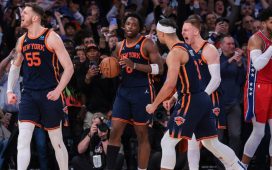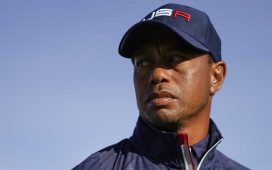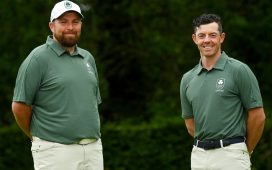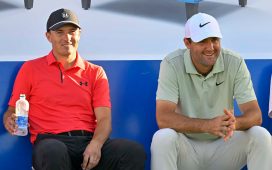Joseph Bramlett had a plastic club in his crib and a poster of Tiger Woods winning the 1997 Masters pinned to his bedroom wall. He dreamed of playing the PGA Tour and by age 22 he did just that.
But just like Woods, Bramlett suffered from crippling back pain that robbed him of several years of his career and had him considering quitting the game. Bramlett is a determined man and he persevered, pushing those thoughts to the back recesses of his mind.
“If you let go of your dream,” Bramlett said, “that’s pretty serious.”
Bramlett now is 31, one of four African-Americans on the PGA Tour. He is three tournaments into his sophomore season after earning one of 25 Tour cards for the 2019-20 season awarded through a three-event playoff in August. On the eve of the kickoff event, A Military Tribute at The Greenbrier, Bramlett looked out the window of the landmark white-columned spring house that serves as the main resort in White Sulphur Springs, West Virginia, and said to his swing instructor, “I can’t believe the PGA Tour is right outside and I get to play in it tomorrow.”
For Bramlett, every week feels like Christmas morning with a new present under the tree. He is making his fourth start of the season this week at the inaugural Bermuda Championship at Port Royal Golf Club. During the past decade, he’s gone from expectations of being the next Tiger Woods to a forgotten man and back to the place where he feels he always belonged.
In 2002, Bramlett became the youngest player at the time to qualify for the U.S. Amateur. He was an All-American at Stanford while leading the school to the 2007 national championship and in late 2010, he became the first African-American to advance through PGA Tour Qualifying School since Adrian Stills in 1985. The similarities to Tiger Woods – right down to the Nike endorsement contract – drew favorable comparisons. But Bramlett finished No. 196 on the 2011 money list and was demoted to the Korn Ferry Tour. He dropped out of the top 25 in the last event and failed to earn a promotion.
“I thought I was going right back to the PGA Tour,” he said. “It was a pretty big letdown when I didn’t get it done.”
On July 1, 2013, his back went out and that’s where the real journey began for Bramlett. He remembers hitting a few soft lob wedges on a range in Utah when he felt a searing pain in his lower back.
“My whole body felt like it was on fire,” he said.
Bramlett spent six weeks on the floor at home, crawling to the kitchen to get food. He was diagnosed with an annular tear to his L-4/L-5 disc, the two lowest vertebrae of the lumbar spine.
“I just wanted a doctor to open me up and fix me,” Bramlett said. “That would have been amazing.”
He consulted 15 different spine specialists, who all agreed that his best option was to insert a steel rod. There was only one problem – that would eliminate his ability to rotate and effectively end his career.
“I could at least get around, but I wanted to play golf. This is what I do,” he said.
So, he endured an 18-month healing process only to end up back on the floor every time he began playing golf again. He made only three starts during a 4 ½-year span from July 2013 through January 2018.
“My back was a ticking time bomb,” he said.
In 2016, Bramlett began working with John Scott Rattan, a teaching professional at Congressional Country Club in Bethesda, Maryland, and they rebuilt his swing.
“His power source, his engine, if you will, wasn’t in the right place,” Rattan said, noting that Bramlett created a reverse spine angle that put excessive pressure on his lower back. “In the past, he worked on the symptom that his back hurt, but so often when you’re looking at back pain, the back is the victim not the culprit.”
“We hit a lot of balls bare foot,” Bramlett said. “Applying the proper pressure to the ground and adjusting how I use my hips and turn my pelvis has made all the difference. Once I mastered those two things the back pain was gone.”
In 2018, Bramlett was on the verge of regaining his PGA Tour card until the last Korn Ferry Tour event of the regular season when he dropped out of the top 25 again. Initially, Bramlett suffered the disappointment of being so close to his goal and yet still so far away. But in reflection, he realized he’d played a full season, including the last 13 weeks in a row, without any pain.
“I proved I could do it,” he said.
And now he’s living his dream again on the PGA Tour and with thoughts of victory swimming in his head.
Said Bramlett: “I grew up dreaming of being the best player in the world and winning major championships and that’s still how I feel.”








